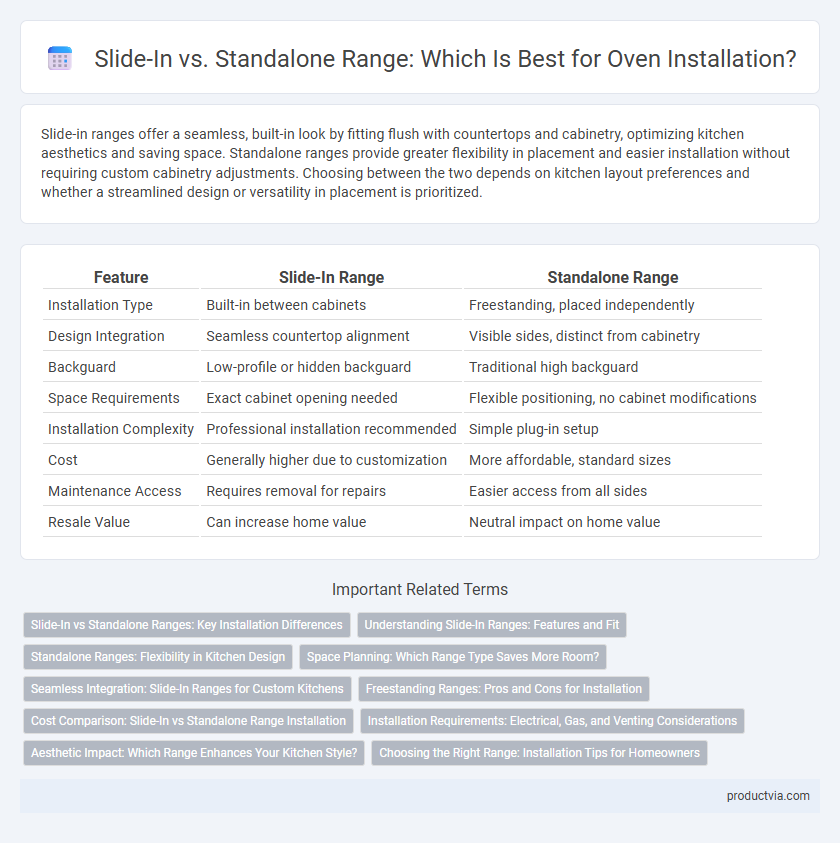Slide-in ranges offer a seamless, built-in look by fitting flush with countertops and cabinetry, optimizing kitchen aesthetics and saving space. Standalone ranges provide greater flexibility in placement and easier installation without requiring custom cabinetry adjustments. Choosing between the two depends on kitchen layout preferences and whether a streamlined design or versatility in placement is prioritized.
Table of Comparison
| Feature | Slide-In Range | Standalone Range |
|---|---|---|
| Installation Type | Built-in between cabinets | Freestanding, placed independently |
| Design Integration | Seamless countertop alignment | Visible sides, distinct from cabinetry |
| Backguard | Low-profile or hidden backguard | Traditional high backguard |
| Space Requirements | Exact cabinet opening needed | Flexible positioning, no cabinet modifications |
| Installation Complexity | Professional installation recommended | Simple plug-in setup |
| Cost | Generally higher due to customization | More affordable, standard sizes |
| Maintenance Access | Requires removal for repairs | Easier access from all sides |
| Resale Value | Can increase home value | Neutral impact on home value |
Slide-In vs Standalone Ranges: Key Installation Differences
Slide-in ranges require precise measurements for a flush fit between cabinets, offering a seamless, built-in appearance with minimal gaps, while standalone ranges are freestanding units that fit within standard kitchen spaces without modifications. Slide-in models often involve integrated controls and a front-facing backsplash that blends into countertops, contrasting with the standalone design featuring finished sides and a gap between the oven and cabinetry. Understanding these key installation differences helps homeowners choose the optimal range type based on kitchen layout, aesthetics, and remodeling scope.
Understanding Slide-In Ranges: Features and Fit
Slide-in ranges offer a built-in look by fitting seamlessly between cabinets and delivering a continuous countertop design, thanks to their front controls and minimal gaps. Designed for kitchen islands or tight spaces, these ranges feature a slightly overlapping cooktop edge that eliminates backsplash gaps, allowing for easier installation and integrated aesthetics. Slide-in models typically lack a rear backsplash, requiring precise countertop cuts but enhancing the modern, streamlined kitchen appearance compared to standalone freestanding ranges.
Standalone Ranges: Flexibility in Kitchen Design
Standalone ranges offer unparalleled flexibility in kitchen design due to their self-contained structure, allowing installation in various locations without the need for built-in cabinetry adjustments. They provide easy access to all sides for maintenance and can be integrated into open-concept layouts or traditional kitchens with minimal remodeling. This adaptability makes standalone ranges ideal for homeowners seeking customizable kitchen configurations and future upgrades.
Space Planning: Which Range Type Saves More Room?
Slide-in ranges save more space in kitchen layouts by fitting flush with countertops and cabinets, creating a seamless, built-in appearance that optimizes available surface area. Standalone ranges require clearance on all sides for installation, resulting in a larger footprint and less efficient use of kitchen space. Choosing a slide-in range enhances space planning by maximizing countertop continuity and minimizing gaps, making it ideal for compact kitchens.
Seamless Integration: Slide-In Ranges for Custom Kitchens
Slide-in ranges offer seamless integration by fitting flush with custom cabinetry, creating a unified and polished look in kitchen designs. Their absence of rear panels allows for easier installation against walls, enhancing aesthetic appeal and maximizing space efficiency. Standalone ranges, in contrast, often leave unsightly gaps and require complementary backsplashes, making slide-in models the preferred choice for sleek, custom kitchens.
Freestanding Ranges: Pros and Cons for Installation
Freestanding ranges offer versatile installation options with built-in side panels that allow easy placement anywhere in the kitchen without requiring custom cabinetry, making them ideal for straightforward setups or renters. Their freestanding design can sometimes create gaps between the range and adjacent cabinets, potentially leading to food or debris accumulation, which requires regular cleaning to maintain hygiene. While slide-in models provide a seamless, built-in appearance by fitting flush with countertops, freestanding ranges are generally more affordable and easier to replace or relocate when remodeling.
Cost Comparison: Slide-In vs Standalone Range Installation
Slide-in ranges generally cost more to install than standalone ranges due to the need for precise fit and custom cabinetry adjustments, which increase labor and material expenses. Standalone ranges offer simpler installation with standard clearances and minimal cabinetry modification, reducing overall setup costs. Budget considerations often favor standalone ranges for affordability, while slide-in models demand higher installation investment reflecting their tailored kitchen integration.
Installation Requirements: Electrical, Gas, and Venting Considerations
Slide-in ranges require precise countertop and cabinetry cutouts for a seamless fit, often demanding dedicated electrical circuits with 240-volt outlets and specific gas line placements if applicable. Standalone ranges offer more flexibility in installation, typically needing standard electrical or gas connections without custom cabinetry modifications, and include built-in venting options or require separate vent hood installations. Proper venting considerations for both types are crucial to ensure safety and compliance with local building codes, particularly when using gas models.
Aesthetic Impact: Which Range Enhances Your Kitchen Style?
Slide-in ranges offer a seamless, built-in look that aligns flush with countertops and cabinetry, creating a sleek, integrated aesthetic ideal for modern kitchens. Standalone ranges are freestanding appliances that provide a bold, traditional statement but may interrupt countertop flow due to their visible sides. Choosing between slide-in and standalone ranges significantly impacts kitchen style, with slide-ins enhancing clean lines and cohesive design, while standalone models emphasize functionality and classic appeal.
Choosing the Right Range: Installation Tips for Homeowners
Choosing between a slide-in and standalone oven hinges on kitchen layout and installation preferences. Slide-in ranges offer a seamless, built-in look by fitting flush with cabinetry and countertops, ideal for a streamlined kitchen design. Standalone ranges provide flexibility in placement and easier installation, making them suitable for kitchens with less customization or frequent layout changes.
Slide-in vs Standalone range for installation Infographic

 productvia.com
productvia.com